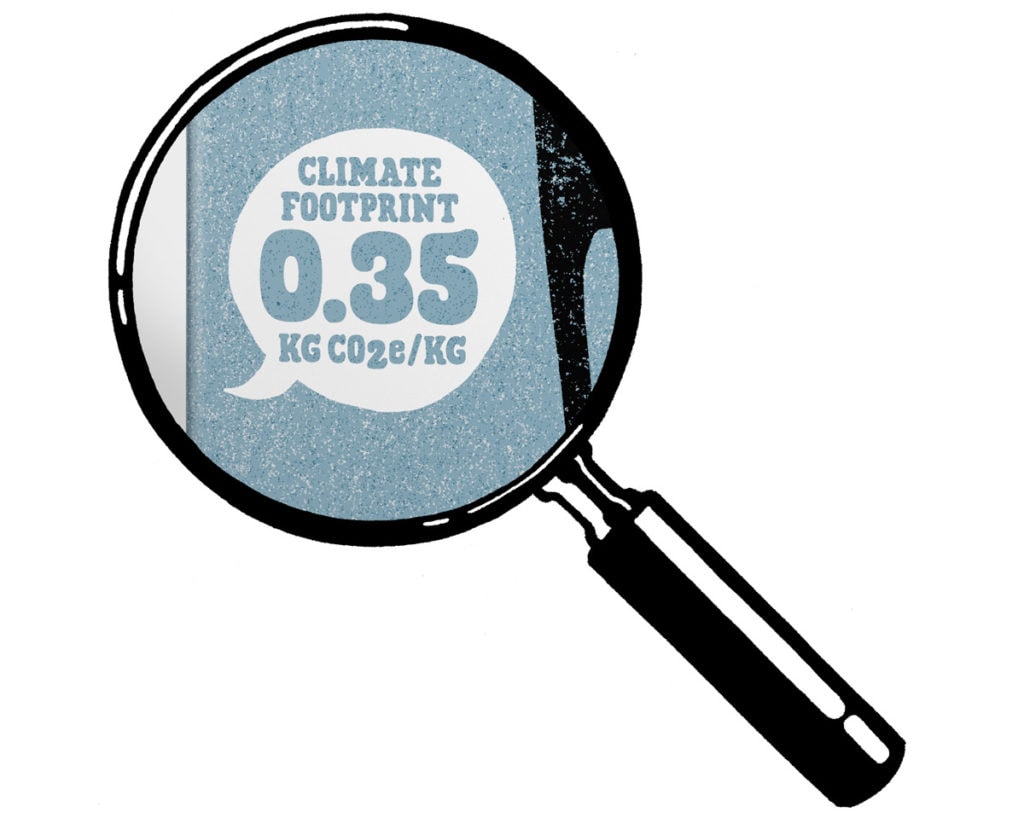Different food products have different carbon footprints. That is an obvious fact. 10 kg of CO₂ translates to 24 avocados, 32 kg of oats – but only 370 g of steak.
Consumers can’t compare footprints “on the go”
Nutritional labels have been present on packaging as long as most of us can remember.
It’s easy to understand the caloric value of a product, its protein, fiber, and fat contents, and the ingredients it was made from. And for a good reason: Consumers should be able to make informed choices about which kinds of products they purchase.
So.
Why is carbon labeling not common practice? Why is it so hard for us to compare different slices of cheese, meats, bananas, and grapes to each other? Why can’t we – literally – compare the carbon footprint of apples and oranges?
Product footprints and Life Cycle Assessment: A practice that requires commitment
Carbon labels are not common practice for three main reasons:
- They are not legally required in any country, and they’re not necessarily boosting sales (to end consumers – throughout the value chain, different parties are definitely interested in product footprints)
- They can’t just be created “on the fly”. Conducting a Life Cycle Assessment means embracing an ISO-normed process with scientific weight – something that you will actually need to spend time on.
- It takes away space on the product packaging – space that can be painfully valuable for other claims.
So, why would a company ever include the carbon footprint on its food packaging?
The answer: Because the legislative and competitive pressure got too high (we have a negative example for this later in the article) – or because they actually care.
In this article, we’ll show you four examples of food companies that put transparency first and include the CO₂ footprint of their products on their packaging.
Avallen Spirits: ‘Bee positive’
Our planet-positive customer Avallen Spirits, used their environmental footprint results to create a new label showcasing it’s carbon footprint on their bottles. The aim: set new sustainability benchmarks for the drinks industry.
The new label showcases how they are climate positive. They remove 2.73kg CO2-eq greenhouse gas emissions from the atmosphere per 70cl of their spirit. They also discuss packaging materials and details of their charitable donations via 1% for the Planet to Bumblebee Conservation Trust.

Oatly: “Show us your numbers”

Swedish oat milk avantgarde Oatly ran a big campaign around their product footprint. Under the headline “Food industry – show us your numbers”, they speak out about their footprint and encourage others to follow. The campaign created a big media echo in 2019.
With only 0,35 kg CO₂ – equivalent, Oatly’s products are much more sustainable than cow’s milk – a fact that the company uses heavily in their advertising to convince potential clients of the benefits of their products. Their analysis included even the packaging and transport phase of their products.

Oatly made use of a Life Cycle Assessment conducted by a Swedish partner. You can read the entire documentation of the process on their website.
Quorn: Transparent meat replacements
In 2020, British meat replacement giant Quorn joined Oatly in their fight for more transparency. Quorn produces meat replacements, mainly based on mushrooms.
In a similar fashion, they added their CO₂ footprint to their packaging. To make the comparison between different products easier, Quorn is always communicating their carbon dioxide equivalent per kg – just like oatly. Now we can see that 1 kg of Quorn Mince accounts for about 1,3 kg of CO₂, while 1 liter of Oatly accounts for 0,35 kg of CO₂.
Of course, you also have to consider the nutritional value. Quorn’s products are packed with a significant amount of protein, while oat milk is mostly based on water. But with full footprint transparency, this is finally possible!

Veganz: Vegan food with a mission
Founded in 2011 by former Daimler manager Jan Bredack, Germany-based Veganz has gained significant traction in the German food wholesale. They strive to be fully transparent – about their pricing as well as their footprint.
Thus, they collaborated with a company called eaternity in order to be transparent not only about their carbon footprint, but also about their usage of water, rainforest, and animal welfare.

Unilever: Putting carbon labels on 70.000 products
Dutch food producer Unilever announced just this month that they will add carbon labels to all of their 70.000 products – a big commitment. They didn’t yet clarify a time goal for this. This initiative is part of their green ambition plan, which also entails a supply chain without deforestation, 1 billion € investments in green projects and a completely carbon neutral supply chain by 2039.
Tesco: The want-to-be frontrunner, that wasn’t
In 2007, British supermarket giant Tesco pledged to add carbon labels to more than 70.000 products. In 2012, they retracted from that idea – “blaming the amount of work involved and other supermarkets for failing to follow its lead”. Apparently, the plan was to be on the forefront of a movement, but the movement never came. The three impact-driven examples show that it’s absolutely possible to go ahead with carbon labeling – even if the competition is still sleeping.
Nestlé: Will they follow through?
Nestlé is one of the biggest food producers in the world, and in April, they communicated they “considered to put carbon labels on their products”. Let’s see if they will go through – other companies are already in motion.
Which other food companies are transparent about their CO₂ footprint?

